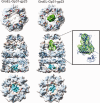ATP-driven molecular chaperone machines
- PMID: 23877967
- PMCID: PMC3814418
- DOI: 10.1002/bip.22361
ATP-driven molecular chaperone machines
Abstract
This review is focused on the mechanisms by which ATP binding and hydrolysis drive chaperone machines assisting protein folding and unfolding. A survey of the key, general chaperone systems Hsp70 and Hsp90, and the unfoldase Hsp100 is followed by a focus on the Hsp60 chaperonin machine which is understood in most detail. Cryo-electron microscopy analysis of the E. coli Hsp60 GroEL reveals intermediate conformations in the ATPase cycle and in substrate folding. These structures suggest a mechanism by which GroEL can forcefully unfold and then encapsulate substrates for subsequent folding in isolation from all other binding surfaces.
Keywords: ATP driven; Cryo-EM; GroEL; chaperones; machines.
Copyright © 2013 Wiley Periodicals, Inc.
Figures









References
-
- Hartl FU, Hayer-Hartl M. Science. 2002;295:1852–1858. - PubMed
-
- Fenton WA, Horwich AL. Q Rev Biophys. 2003;36:229–256. - PubMed
-
- Bukau B, Weissman J, Horwich AL. Cell. 2006;125:443–451. - PubMed
-
- Hartl FU, Hayer-Hartl M. Nat Struct Mol Biol. 2009;16:574–581. - PubMed
-
- Hartl FU, Bracher A, Hayer-Hartl M. Nature. 2011;475:324–332. - PubMed
Publication types
MeSH terms
Substances
LinkOut - more resources
Full Text Sources
Other Literature Sources
Research Materials
Miscellaneous

